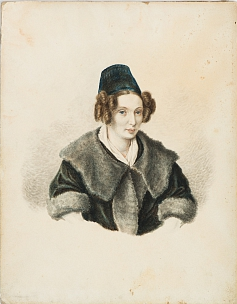In Russian museum of 1812 in Moscow three exhibitions are held.
The first one, which is small, but warm, composed of a few stands at the end of the main exposition, transfers us in the middle of XIX century, in family life of rebellious Russian aristocrats-decembrists. It is called «Wifes of decembrists» and represents drawings (after 1850s photos) of wifes and children of decembrists.

We can’t say the exhibitions gives us something newabout decembrists. 126 young men were condemned to death or hard labour or exile. 23 of them only were married at the moment of the sentence. 11 wifes and 2 brides arrived in Siberia to their husbands. Women linked decembrists and their families, they helped prisoners to ennoble life.
Sharing fate with husbands was poetized by Russian poet N. Nekrasov in «Russian women», and we are common from school to honour those who fulfilled matrimonial debt as feat. At the same time, until now other prisoners, especially from peasants, followed by their wifes and husbands, are unknown even they suffered much more. In XIX century people had no habit to refuse from families in difficult times. And it is important to know, that most of decembrists informed their household in advance for participance in clandestine societies. And families usually had same opinion.
Thus nice spiritual faces from ancient drawings and photos just renind us of times when family was strong, when love was valued over life problems and matrimonial debt was obligatory.
The second exhibition “Alexander Gerasimov. To 135-anniversary of the painter” is dedicated to the biggest soviet painter A. Gerasomiv (1881-1963), who was favorit of I. Stalin, academic and the first president of Russian Academy of Art in 1947-1957.
The exhibition is big, it shows 90 paintings of different types from Russian and Historical museums. Owing to content and its allocation, we can evidently feel widely-known social-realistic period together with impressionistic, which is known less.
A. Gerasimov studied at College of painting, sculpture and architecture as painture and architect. He studied from K. Korovin, V. Serov and A. Arkhipiv. He was acknowledged in tsar period. Famous admirer and friend was writer V. Gilyarovsky.

Gerasimov started his way of court painter with work «Lenin on rostrum» in 1930. Then he painted Stalin, who got well-known image of kind and calm leader. The works were painted in high quality, with large red color, gala and without extra-sugariness.
In Soviet times the painter created series of water-color painting upon the results of his world journey: we see beautiful views of Bombey, Shanghai and Istambul. The works are painted with mastery, with profound comprehention of cultures and imaging sites – for example, painting of St. Sofia interior in Istambul, where arab recast ща Christian church is highlighted in rich colors.
Also in Soviet period series after «Taras Bulba» by Gogol was painted («Stop, my pipe with tobacco dropped out») and number of portraits (including A.V. Sveshnikov, creator of Russian Chorus and head of Moscow conservatoire).
Early and late works, painted by inspiration, are amazing the persistent follow the Russian impressionist culture. After discharge from Academy of Art, Alexander Michailovich painted «Polovtsy danse», being already mature artist, but in the same style he began profession.
All these feelings gives us the exhibition, unveiling contradiction of this strong and talanted person. There is icon of Jesus Almighty among the things from workshop. This shows keeping of routes. In spite collaboration with authorities and participance in political activities, the painter preserved some principles and ideals, which he defended and because of it he fell from grace in times of Khrouschev.
The third exhibition is dedicated to Armenia. It is called «Armenia. Legend of life» and represents over 160 unique artefacts from three leading museums of Armenia: Museum of History of Armenia, Museums of the first St. Achmiadzin and Institute of ancient manuscripts Matenadaran named after Mesropa Mashtotsa.
Source: Museum of 1812




